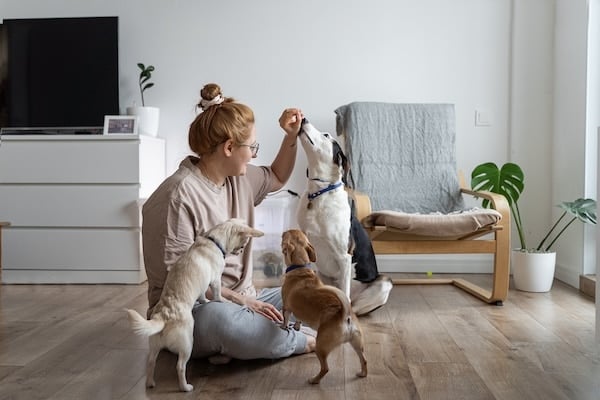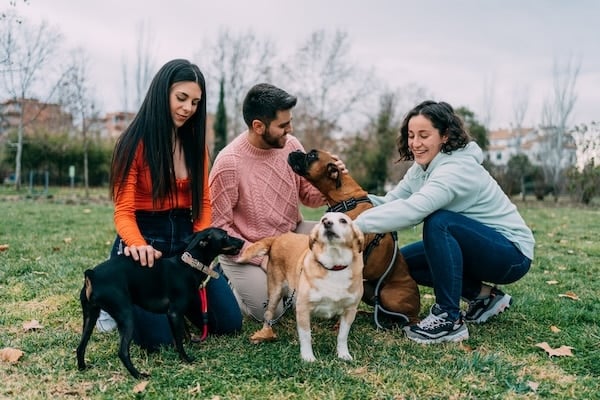- This post contains affiliate links. Read more here.
- Not a substitute for professional veterinary help.
If you’ve already lined up a vet, trainer, and groomer, securing a trusted pet sitter is likely next on your agenda. But knowing how to find a good dog sitter can feel daunting, especially when your pup’s well-being is at stake. Fortunately, you have many options, from private in-home sitters to veterinary boarding facilities. The real challenge is determining which option best suits you and your pet—and knowing where to start your search.
To guide you through the process, we consulted Ivan Petersel, certified dog trainer (CPDT-KA) and founder of Dog Wizardry. Below, we’ll explore the pros and cons of different sitter options, share expert tips for vetting sitters, and highlight critical red and green flags to watch for. We’ll also cover how to prepare for a successful meet and greet with potential sitters.
Where To Find a Dog Sitter
The first step to choosing a reliable pet sitter is knowing where to look. And knowing where to look will depend on what type of service you want. Here’s a look at the pros and cons of each type of sitter to help determine your search.
1. Private doggy daycare in a sitter’s home
Private doggy daycare takes place in the sitter’s home with a small number of dogs and typically costs around $40 per day. This service offers more personalized attention in a relaxed, homey atmosphere, making it ideal for dogs who like socializing in smaller playgroups.
Availability can be limited, however, as most sitters can only accommodate a few dogs at a time. It’s also worth noting the pet-sitting industry is not heavily regulated, so it’s important to carefully vet your sitter if you aren’t going through an agency that does it for you.
You can find private daycare through our platform at Rover, which lets you browse profiles, read reviews, and filter results by specific needs, such as overnight care or willingness to give medications. You can also search for qualified professionals through organizations like Care.com, the National Association of Professional Pet Sitters (NAPPS), and Pet Sitters International (PSI).
2. Private doggy daycare in your home
In-home doggy daycare involves a sitter coming to your house to care for your dog during the day. This service can be a good option for pups needing more personalized care, like seniors, young puppies, and dogs with anxiety or specific health concerns. It lets them keep their usual routine in a familiar environment.
One drawback is cost—this option is typically pricier than traditional daycare. Additionally, inviting someone into your home requires significant trust, so you’ll need to vet potential sitters thoroughly.
To find and vet an in-home pet nanny, you can use the platforms listed above.

Maria Levkina via iStock
3. Doggy daycare facilities
Traditional doggy daycare facilities with professionally trained staff offer a structured environment for dogs to socialize and play with other pets. It can be an excellent option for social butterflies and high-energy dogs. However, it’s often less suitable for dogs with anxiety or specific behavioral issues like reactivity, who might find the environment overwhelming.
To find a reputable daycare facility, seek recommendations from fellow pet parents and check online reviews. Many facilities offer tours or trial days, allowing you to assess their cleanliness, environment, and staff before committing.
4. Overnight boarding with a sitter
Hiring a private sitter to care for your dog overnight in their home is a relatively affordable option. The main advantage is the comfort and personalized attention your dog receives. This option is ideal for dogs who thrive on individual attention and may feel anxious in crowded environments like kennels.
You can find overnight sitters through platforms like Rover and Care.com. You can also ask for suggestions in community Facebook groups or neighborhood platforms like NextDoor.
5. Overnight boarding in your home
This option involves hiring a sitter to stay overnight in your home. Dogs sensitive to new environments or those with specific routines will benefit most from this arrangement. However, it might be more expensive than boarding at a sitter’s home, and you’ll need to vet the sitter thoroughly.
Look for local pet sitters on dog-sitting apps like Rover, platforms like TrustedHousesitters, or through personal recommendations from friends and family.
6. Dog boarding facilities
For social and adaptable dogs who thrive on activity, a traditional boarding facility might make the most sense. Many facilities provide social interaction with other pets and have trained staff who can cater to specific needs, like managing meds or providing specialized diets. Finding appropriate facilities to board anxious or reactive dogs can be trickier, but it’s feasible with some investigating.
Like daycares, most boarding facilities welcome potential clients to tour their grounds. Dogs require different levels of care, so it’s best to visit beforehand or schedule a brief trial stay to evaluate the facility.
7. Overnight boarding at your veterinary clinic
Some veterinary clinics offer boarding services where care is overseen by trained professionals who understand your dog’s medical history. In an emergency, pets have quick access to veterinary support, making this an ideal option for dogs with serious health issues. However, space may be limited, especially during busy times, and some clinics may not have staff on-site overnight.
If your veterinary clinic doesn’t offer boarding, ask them for a recommendation in the area. Friends, family, fellow pet parents, and online community boards are also great places to search.
8. Enlist the help of family and friends
Relying on dog-savvy friends or family can be a practical and comforting choice. Your dog will receive personalized attention from someone you know and trust. Just consider that not all dog lovers possess the skills for effective care, and any issues that arise could impact your relationship with the caregiver.

LuckyBusiness via iStock
How To Vet a Potential Dog Sitter
Now that you know the type of sitter you want and where to look for them, it’s time to start narrowing your search. Whether or not you should trust a dog or cat sitter will depend heavily on your vetting process. Here’s how to start.
1. Read online reviews and ratings
Check out testimonials via Google, Yelp, and various social media platforms. Pay attention to the overall sentiment. Are reviews mostly positive, or are there recurring negative concerns?
Look for important details about the sitter’s overall behavior, like their punctuality, communication, and attitude toward pets. You can also search the reviews to see if they have the experience needed for your particular pup, such as being able to walk a leash-reactive dog.
2. Look for shared philosophies on pet care
Dog-sitting apps like Rover offer the sitter’s bio, providing valuable insights into their experience and approach to pet care. This overview often includes their take on things like managing unwanted behavior, pets on furniture, enrichment, or how often your dog will be left alone.
Dog trainer Ivan Petersel advises prioritizing sitters who are familiar with positive reinforcement. Pet sitters with a fear-free certification are also often knowledgeable about canine body language and how to reduce stress, fear, and anxiety.
3. Seek personal recommendations
Don’t hesitate to ask friends, family, neighbors, coworkers, your groomer, or your vet for suggestions. Anyone with experience caring kindly for pets will likely have a reliable recommendation.
What To Ask a Prospective Dog Sitter
Once you’ve identified a promising dog sitter or two, there are some essential things to ask upfront. Here are several key topics worth discussing.
What are your rates?
Ask if the sitter charges extra for overnight stays, holidays, or additional pets. Try to find sitters with qualifications or experience that justify their fees.
You can research average rates in your area to determine how much to pay someone to watch your dog. Remember, the cheapest option may not always provide the best care, so aim to balance your budget and the quality of service.
What services do you provide?
Clarify the specific services the sitter offers. Do they provide regular walks, grooming, or specialized care? If your pet requires medication, ensure the sitter is experienced and willing to administer it safely.
For peace of mind, ask about any relevant certifications or training they have in pet care and whether they are bonded and insured.
How would you handle certain emergency situations?
Petersel recommends asking sitters how they would handle specific emergencies. You can pose hypothetical situations, like what they would do if your pet became ill or escaped. You can also ask what their plan would be for transporting your pet to the vet in an emergency.
Can you accommodate my dog’s specific needs?
Every dog has unique needs, especially if they are reactive, elderly, or require medication. Puppies can be a handful, too, and may benefit from a sitter with puppy experience. If you have a reactive or anxious dog, Petersel says to ask about the sitter’s experience managing such behaviors.
You should also talk about your dog’s routine, including feeding schedules, exercise needs, and any behavioral quirks the sitter should know.

Juan Hernandez Carmona via iStock
Schedule a Meet & Greet
Once you find a sitter who seems like a good fit, it’s time to schedule an in-person meeting. This lets you observe how the sitter interacts with your pet before making a decision—and it gives the sitter a chance to see if your dog is a good fit for them.
How to prepare for a meet and greet
- Set the time and place. Select a comfortable location for both you and the sitter. This could be your home, their home, or a local park—just make sure it’s a place where your pet feels comfortable so they’re in a calm state and you can gauge their reaction to the sitter.
- Make a list of questions. Prepare questions to ask the sitter regarding their experience and availability. You can also gather important information about your pet for your sitter ahead of time. These details might include dietary needs, medical history, and specific behavioral quirks.
- Observe interactions. Pay close attention to how the sitter interacts with your pet during the meeting—they should be warm and enthusiastic. Watch your pup, too. They should appear comfortable and happy.
Red versus green flags
Just like on a first date, there are signs to look out for during your initial meet and greet to determine if it’s going to be a good match.
According to Petersel, green flags include the following:
- Enthusiasm and interest. The sitter should show genuine interest in your pet and ask thoughtful questions about their care and routine. “They should be curious about your dog’s habits, likes, dislikes, allergies, and more,” he says.
- Positive interaction with your pet. Your pet should appear comfortable and relaxed around the sitter and be encouraged to interact with them.
- Open communication. The best dog sitters will be communicative and respond to messages promptly. If the sitter is receptive to your concerns and feedback and is willing to collaborate, that’s a good sign.
Potential red flags, however, might include:
- Hesitance to meet in person. If the sitter is unwilling or hesitant to set up a meet and greet, it could indicate a lack of commitment or professionalism.
- Reluctance to discuss contracts or insurance. Petersel advises looking for someone who takes their role seriously. Exercise caution if they avoid discussing contracts or insurance when you bring it up.
- Dismissive attitude. If the sitter seems disinterested in your questions or your pet’s needs, that’s a major warning sign. “They should be asking a lot of questions,” says Petersel. “A lack of curiosity is a red flag.”
What Not To Do
Throughout your search for the perfect dog sitter, you’ll want to avoid a few common pitfalls. Refraining from these mistakes makes for a better experience for all involved parties.
- Conducting “gotcha tests.” During the meet and greet, avoid surprising the sitter with unexpected tests or trying to catch them off guard. Creating these little traps can add unnecessary pressure and lead to an unfair assessment of the sitter’s abilities.
- Being dishonest about your dog’s needs. Lying or downplaying your dog’s behaviors is a big no-no, says Petersel. Misrepresenting your dog’s needs could lead to mismatched expectations and potentially unsafe situations. If your dog has specific triggers, Petersel says to disclose this information upfront.
- Neglecting to explain boundaries. Clearly outline any restrictions or preferences, such as areas of the house your dog isn’t allowed to access or rules regarding cleanliness. Communicating these details ahead of time can prevent misunderstandings.
- Ignoring compatibility. Not all sitters are a perfect fit for every dog. Don’t overlook how your dog and sitter interact and if they seem to mesh well. Petersel says you can assess this with a thorough introduction.




